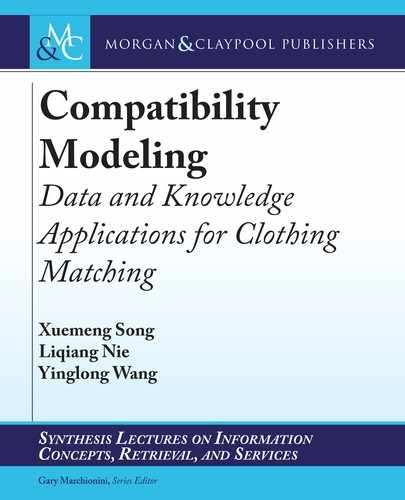
7.2. RELATED WORK 81
A Wardrobe
Garment Modeling
User Modeling
User-Garment
Compatibility
Garment-Garment
Compatibility
Wardrobe
Compatibility
Image
Item
Preference
Factor
Item Body
Shape Factor
User
Preference
Factor
User Body
Shape Factor
Body Shape
Assignment
Scheme
Pink Shirt
Longsleeve
Chiffon
Text
softmax
LSTM
LSTM
softmax
LSTM
LSTM
softmax
LSTM
LSTM
Brown
Coat
Pink
Shirt
Button
Short
Figure 7.2: Schematic illustration of the scoring model, consisting of the user modeling and
garment modeling.
shape, to measure the user-garment compatibility. To tackle the heterogeneity of user aspect
and garment, we learn the user-garment compatibility in the latent matching space via a cross-
modal projection. Different latent spaces are associated with different user aspects to highlight
their difference for the user-garment compatibility.
1
Pertaining to the garment modeling, we
adopt a bidirectional LSTM to measure the compatibility among garments, which is an efficient
method to assess the outfit compatibility based on the visual appearances and textual descrip-
tions of items. Finally, the wardrobe compatibility is estimated via the linear combination of the
user modeling and garment modeling.
7.2 RELATED WORK
7.2.1 USER MODELING
User Preference Modeling. User preference modeling is gaining increasing research interest for
its applications ranging from the fashion domain [34, 35] to online social networks [5, 91]. In
this research line, MF has become a popular and effective framework [44, 93], which aims to
uncover the latent user/item factors that affect people’s preference behavior. For example, Hu
et al. [44] first associated different “confidence levels” to the positive and non-observed user
feedback and then perform the factorization over the user-item rating matrix. Noticing that
previous works just regarded the missing feedback as negative one and failed to directly optimize
the model for ranking, Rendle et al. [100] proposed a generalized BPR framework, where the
user-specific order of two items is exploited by the Bayesian analysis. ereafter, due to its great
success, several extension efforts on BPR have been put forward in fashion domain. For example,
He et al. [34] introduced the Visual Bayesian Personalized Ranking (VBPR), where the latent
visual factor is incorporated to model the user’s preference on the visual appearance of fashion
1
Note that other user aspects, like age and occupation, could be easily incorporated in the similar manner.
..................Content has been hidden....................
You can't read the all page of ebook, please click here login for view all page.
